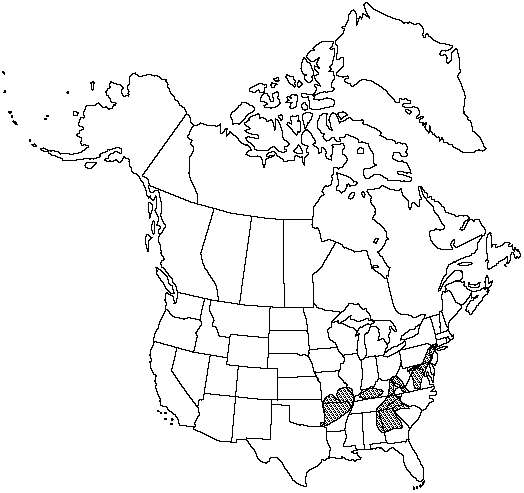Asplenium bradleyi
Bull. Torrey Bot. Club 4: 11. 1873.
Roots not proliferous. Stems short-creeping to ascending, occasionally branched; scales dark reddish to brown throughout, narrowly deltate, (2–) 3–5 × 0.2–0.4 mm, margins entire or shallowly dentate. Leaves monomorphic. Petiole reddish or purplish brown throughout, lustrous, 1–10 (–13) cm, 1/3–3/4 length of blade; indument of brown, narrowly lanceolate scales at base, grading into hairs. Blade narrowly oblong to lanceolate, pinnate-pinnatifid to 2-pinnate, 2–17 (–20) × 1–6 cm, thin to moderately thick, sparsely pubescent; base truncate or obtuse; apex acute, not rooting. Rachis reddish or purplish brown proximally, fading to green in distal 1/3–2/3, lustrous, sparsely pubescent. Pinnae in (3–) 5–15 (–25) pairs, ovate, obovate to lanceolate or deltate-lanceolate; medial pinnae 6–40 × 3–10 mm; base truncate to obliquely obtuse; margins dentate to denticulate; apex acute or rounded. Veins free, barely evident. Sori 3 to numerous pairs per pinna, on both basiscopic and acroscopic sides. Spores 64 per sporangium. 2n = 144.
Habitat: Acidic rocks, usually on steep ledges
Elevation: 0–1000 m
Distribution

Ala., Ark., Ga., Ill., Ky., Md., Mo., N.J., N.Y., N.C., Ohio, Okla., Pa., S.C., Tenn., Va., W.Va.
Discussion
Asplenium bradleyi is a morphologically variable species, the allotetraploid derivative of A. montanum × platyneuron (W. H. Wagner Jr. 1954; D. M. Smith and D. A. Levin 1963; C. R. Werth et al. 1985). The sterile diploid form of A. bradleyi has been collected twice in nature (W. H. Wagner Jr. et al. 1973; A. M. Evans 1988), and isozyme studies indicate that the allotetraploid has had a polytopic origin (C. R. Werth et al. 1985b). Occurring rarely to locally in the Appalachian region, A. bradleyi overlaps with both progenitor taxa, but it is fairly frequent in the Ozark and Ouachita region where A. montanum is absent. Sterile hybrids with A. pinnatifidum (A. × gravesii), A. montanum (A. × wherryi D. M. Smith et al.), and A. platyneuron are known from nature.
Selected References
None.
Lower Taxa
"thin" is not a number."/3lengthofblade" is not declared as a valid unit of measurement for this property.